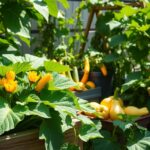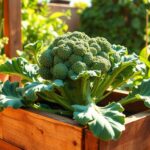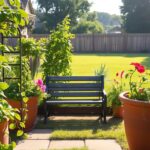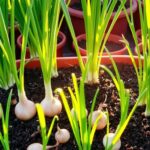Have you ever wondered if you can enjoy fresh, homegrown vegetables even with limited space? The answer is yes! Container gardening is a fantastic way to cultivate your favorite plants, and bell peppers thrive in this setup. I’ve personally found it to be a rewarding and convenient method, especially for urban gardeners or those with small balconies.
One of the best things about using containers is their portability. You can easily move your plants to catch the perfect amount of sunlight or protect them from harsh weather. Plus, it’s much easier to manage soil quality and drainage in a pot compared to a traditional garden bed.
In this guide, I’ll walk you through everything you need to know, from choosing the right container size to ensuring your pepper plant gets the care it needs to produce vibrant, flavorful fruit. Whether you’re a beginner or an experienced gardener, this method is simple and effective.
Key Takeaways
- Container gardening is ideal for urban spaces and small balconies.
- Portability allows for better sunlight and weather management.
- Proper soil and drainage are easier to control in pots.
- Bell peppers require at least 6 hours of sunlight daily.
- Regular watering and fertilization are key to healthy plants.
Container Gardening Basics for Bell Peppers
Container gardening opens up a world of possibilities for small-space growers. It’s a versatile method that allows you to cultivate vibrant vegetables even in tight spaces. One of the standout benefits is the ability to control the environment, ensuring your plants thrive.
Why Choose Containers?
Using containers offers improved root control, preventing overcrowding compared to traditional ground gardening. This setup also makes it easier to manage moisture levels and heat retention, which are crucial for healthy plants. Plus, you can move your pots to optimize sunlight exposure during the day.
Another advantage is the ability to grow a wide variety of peppers. From sweet to hot types, containers accommodate diverse needs. This flexibility is perfect for urban gardeners or anyone with limited outdoor space.
Practical Tips for Success
Choosing the right container size is essential. Larger pots retain heat better and allow for proper root development. Smaller containers, on the other hand, are ideal for compact spaces but require more frequent watering.
Understanding your plants’ basic needs is key. Consistent watering and nutrient absorption are critical for healthy growth. Compared to ground planting, container gardening reduces maintenance and minimizes pest issues, making it a hassle-free option.
Choosing the Right Container and Potting Mix
Selecting the right container and soil mix is crucial for thriving plants. The size and material of your pot, along with the quality of the soil, directly impact root development and overall health. Let’s dive into the essentials to ensure your plants flourish.
Optimal Container Sizes and Options
For healthy root systems, a pot of at least 3 gallons is essential. Larger containers, like 5-gallon buckets, are ideal as they provide more space for roots to spread. This helps prevent overcrowding and supports better nutrient absorption.
If you’re reusing pots, make sure to clean them thoroughly to eliminate any lingering pathogens. This step is critical to avoid introducing diseases to your new plants.
Benefits of High-Quality Potting Mix
A good potting mix should be nutrient-rich and well-aerated. Look for soil with a pH between 6.0 and 6.8, as this range ensures optimal nutrient availability. Proper aeration is also key to preventing waterlogging and root rot.
Comparing Container Materials
Different materials affect soil temperature and moisture retention. Clay pots retain moisture well, making them suitable for warmer climates. Plastic pots are lightweight and easy to move, while fabric pots offer excellent aeration and root pruning benefits.
By choosing the right container and soil, you set the stage for a bountiful harvest. Whether you’re growing sweet or hot varieties, these tips will help you achieve success.
How to Grow Bell Peppers in Containers
Starting your gardening journey with seeds can be both exciting and rewarding. The process of nurturing a plant from its earliest stages is deeply satisfying, and with the right techniques, you can ensure a healthy and productive harvest. Let’s dive into the step-by-step planting process to set you up for success.
Step-by-Step Planting Process
Begin by selecting high-quality seeds. I recommend starting indoors using seed trays filled with a nutrient-rich potting mix. Pre-moisten the soil to ensure it’s damp but not soggy. Plant the seeds about 1/4 inch deep, spacing them evenly to allow room for growth.
Water the seeds gently, keeping the soil consistently moist. Overwatering can lead to root rot, so moderation is key. Place the trays in a warm, sunny spot, ensuring they receive at least 6 hours of indirect sunlight daily. Within 7-10 days, you should see the first signs of germination.
After 2-3 weeks, when the seedlings have developed their first true leaves, it’s time to transplant them into larger pots. Choose containers with a minimum size of 3 gallons to accommodate root growth. This step is crucial for promoting strong, healthy plants.
Fertilization is essential for robust growth. Start with a light feed once the seedlings are established, gradually increasing to full-strength fertilizer as the plants mature. I suggest using a balanced, water-soluble fertilizer every two weeks to ensure optimal nutrient absorption.
If you encounter issues like yellowing leaves or stunted growth, check for overwatering or nutrient deficiencies. Adjust your care routine accordingly, and your plants will thrive. With patience and attention, you’ll soon enjoy a bountiful harvest.
Lighting, Sunlight, and Temperature Essentials
Proper lighting and temperature are critical factors for a successful harvest. Whether you’re cultivating a specific pepper variety or aiming for a bountiful season, understanding these elements can make all the difference.
Full Sun vs. Shade: Finding the Right Balance
Bell pepper plants thrive under full sun, ideally receiving around 12 hours of direct sunlight daily. However, during the hottest parts of the day, some shade is necessary to prevent sunscald. I’ve found that moving pots to shaded areas during peak heat helps protect the flower buds and ensures healthy fruit development.
In my experience, using LED grow lights can supplement natural sunlight, especially during shorter days. This combination provides consistent light exposure, promoting balanced growth throughout the season.
Monitoring Temperature Conditions
Temperature plays a significant role in plant health. Daytime temperatures around 75°F are ideal, while nighttime temperatures should stay above 50°F. I recommend using a thermometer to monitor conditions and adjusting the positioning of pots as needed.
Too much direct sunlight can stress the plants, leading to wilting or reduced fruit production. By creating a balanced environment, you can support both early growth and fruit maturation effectively.
Actionable Tips for Success
- Ensure at least 6 hours of direct sunlight daily, with some shade during peak heat.
- Use LED grow lights to supplement natural light during shorter days.
- Monitor temperatures regularly and adjust pot placement to avoid extremes.
- Protect flower buds by providing shade during the hottest hours.
By paying attention to lighting and temperature, you can create an optimal environment for your plants to thrive. These simple adjustments can lead to a healthier harvest and more flavorful results.
Supporting Your Pepper Plants: Stakes, Cages, and Trellises
Ensuring your plants have the right support can make all the difference in their growth and productivity. Taller or heavier varieties often struggle under their own weight, especially during windy conditions or when laden with fruit. Providing proper support not only prevents breakage but also promotes healthier, more robust plants.
Comparing Staking Versus Caging for Support
Staking is a straightforward method that works well for individual plants. A sturdy stake, placed 2-3 inches from the base and secured with soft ties, offers excellent stability. This method allows for better air circulation, reducing the risk of disease. However, it may not be sufficient for bushier varieties.
Cages, on the other hand, provide 360-degree support, making them ideal for plants with sprawling growth habits. They’re especially useful during heavy fruit loads, as they distribute weight evenly. While cages take up more space, they’re a reliable choice for maintaining plant structure.
Creative Uses for Tomato Cages as Trellises
Tomato cages are a versatile and cost-effective solution for supporting plants. Their conical shape and sturdy design make them perfect for repurposing as trellises. Simply place the cage over the plant and gently guide the stems through the openings as they grow. This method not only provides support but also adds a neat, organized look to your garden.
For taller varieties, consider stacking two cages together for added height. This creative approach ensures your plants have the support they need throughout the season.
Installing support systems early is crucial. Waiting too long can lead to damaged stems or uneven growth. Whether you choose stakes, cages, or trellises, timely support ensures your plants thrive and produce a bountiful harvest.
Companion Planting and Spacing Strategies
Companion planting is a smart way to boost your garden’s health and productivity. By pairing the right plants together, you can improve yields, enhance flavor, and reduce pest issues. However, it’s equally important to avoid unfavorable combinations that might harm your plants.
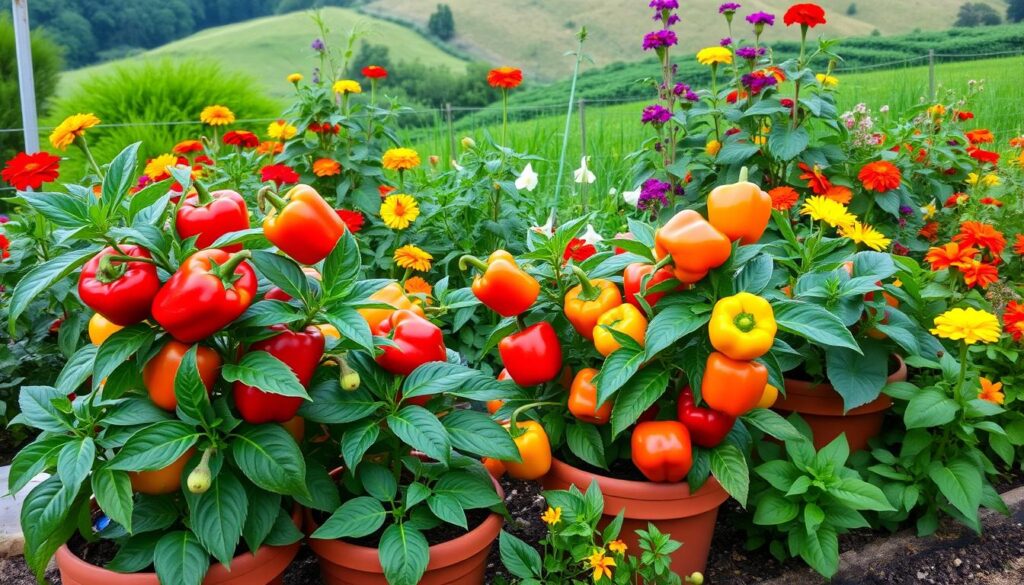
Pairing with Tomatoes and Other Crops
Tomatoes and peppers make excellent companions. Both thrive in similar weather conditions and benefit from the same soil nutrients. Planting them together can save space and create a balanced garden ecosystem. In addition, herbs like basil and oregano can deter pests and improve flavor.
Other great companions include marigolds, which repel nematodes, and alliums like garlic and onions, which deter aphids. These pairings not only protect your plants but also enhance their growth throughout the year.
Avoiding Unfavorable Planting Combinations
Not all plants grow well together. For example, avoid planting peppers near brassicas like cabbage or broccoli. These plants release compounds that can stunt pepper growth. Similarly, fennel can interfere with nutrient absorption, leading to poor conditions for your peppers.
Another combination to avoid is planting peppers near potatoes or eggplants. These plants share common pests and diseases, increasing the risk of infestations. Proper spacing is crucial to prevent overcrowding and ensure each plant gets enough sunlight and nutrients.
Spacing Strategies for Optimal Growth
Proper spacing is key to a healthy garden. For peppers, maintain at least 18 inches between plants to allow for adequate airflow and root development. Use a stake or cage to support taller varieties and prevent them from shading smaller plants.
In addition, consider interplanting with low-growing crops like spinach or carrots. These plants provide ground cover, retain moisture, and attract beneficial insects. By following these strategies, you can create a thriving garden that produces a bountiful harvest year after year.
Optimizing Water, Fertilizer, and Nutrient Management
Mastering water and nutrient management is the key to thriving plants in any gardening setup. Proper care ensures healthy growth, vibrant fruit, and minimal pest issues. Let’s explore the best practices for watering, fertilizing, and maintaining optimal nutrient levels.
Watering Techniques for Healthy Plants
Consistent watering is essential for plant health. I recommend checking the potting mix daily to ensure it’s moist but not waterlogged. Overwatering can lead to root rot, while underwatering stresses the plant and affects fruit production.
Water at the soil level to avoid wetting the leaves, which can cause sunscald. During hot weather, containers may need daily irrigation. Adjust your schedule based on seasonal changes and weather conditions to meet your plant’s needs.
Fertilizer Adjustments for Optimal Growth
Peppers require a balanced diet of nutrients to thrive. Start with a light feed once the seedlings are established, gradually increasing to full-strength fertilizer as the plants mature. A balanced, water-soluble fertilizer every two weeks works well.
I follow a specific schedule: Week 1 – Epsom Salt and Miracle-Gro, Week 2 – Normal Water, Week 3 – Myco Tea, and Week 4 – Normal Water. This routine ensures consistent nutrient absorption and prevents deficiencies.
Maintaining Nutrient Balance in the Soil
Soil pH plays a crucial role in nutrient availability. Aim for a pH between 6.0 and 7.0 to support healthy growth. I use a soil test kit to check nutrient levels and make adjustments as needed.
Secondary nutrients like magnesium and calcium are also important. Epsom salt can enhance magnesium levels, promoting dark green leaves and vibrant fruit. Avoid over-fertilization, as it can lead to nutrient burn and stunted growth.
Preventing Pest Issues and Stem Rot
Proper watering techniques can minimize pest problems and prevent stem rot. Overwatering creates a damp environment that attracts pests and weakens the plant’s structure. Ensure good drainage and airflow around the plant to keep it healthy.
By following these strategies, you can create an optimal environment for your plants to thrive. Consistent care and attention to detail will reward you with a bountiful harvest.
Conclusion
Successfully cultivating vibrant vegetables in limited spaces is achievable with the right approach. This guide has covered everything from selecting the ideal place for your garden to ensuring the correct number of steps are followed for optimal results. Proper planning, consistent care, and timely support are essential for a thriving harvest.
Remember, choosing the right container, maintaining soil quality, and providing adequate sunlight are key factors. Regular watering and fertilization will keep your plants healthy and productive. By applying these tips, you can enjoy a bountiful yield even in small spaces.
I encourage you to revisit the detailed sections of this guide for a full refresher on best practices. With dedication and attention to detail, anyone can create a flourishing garden. Happy gardening!

